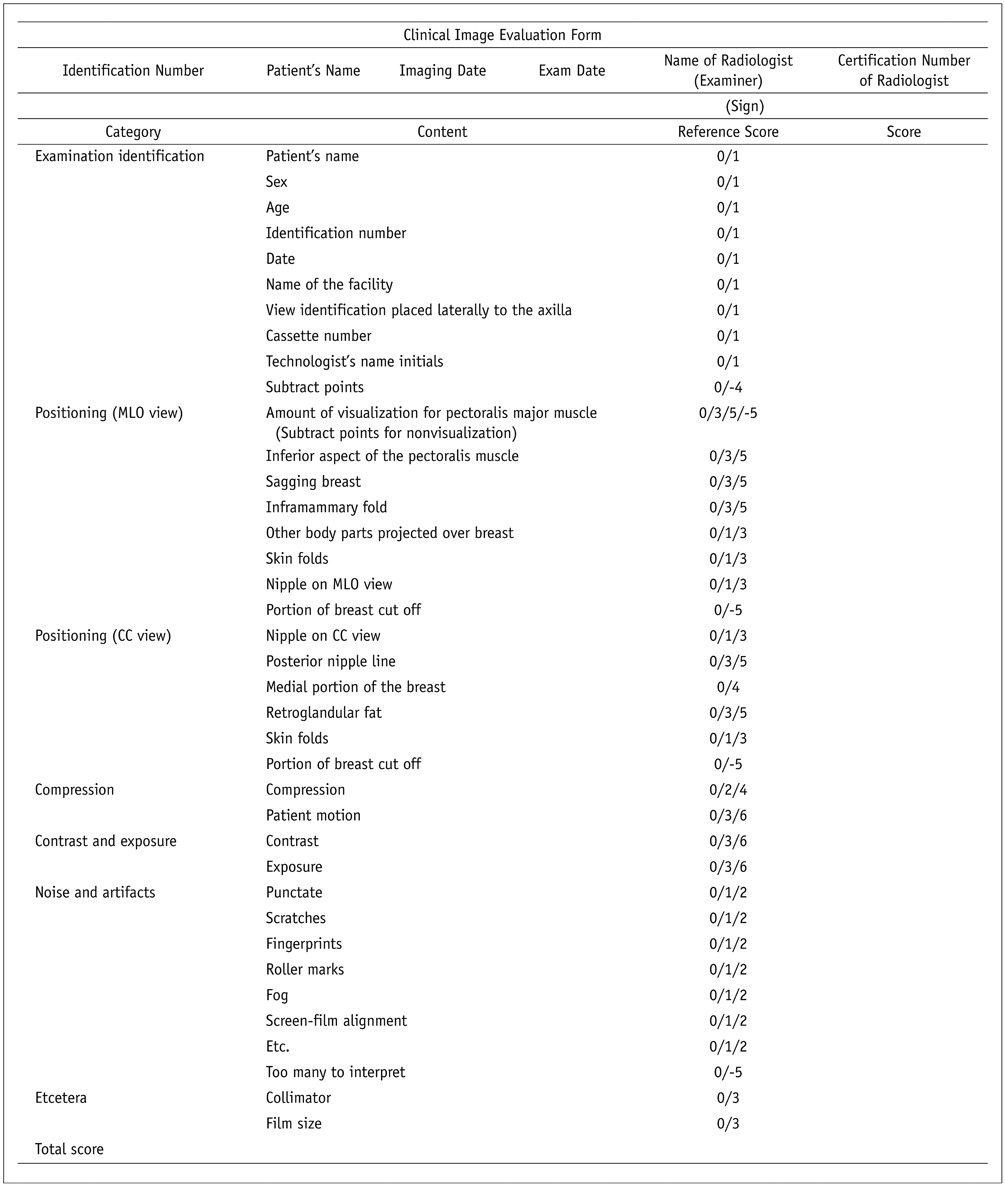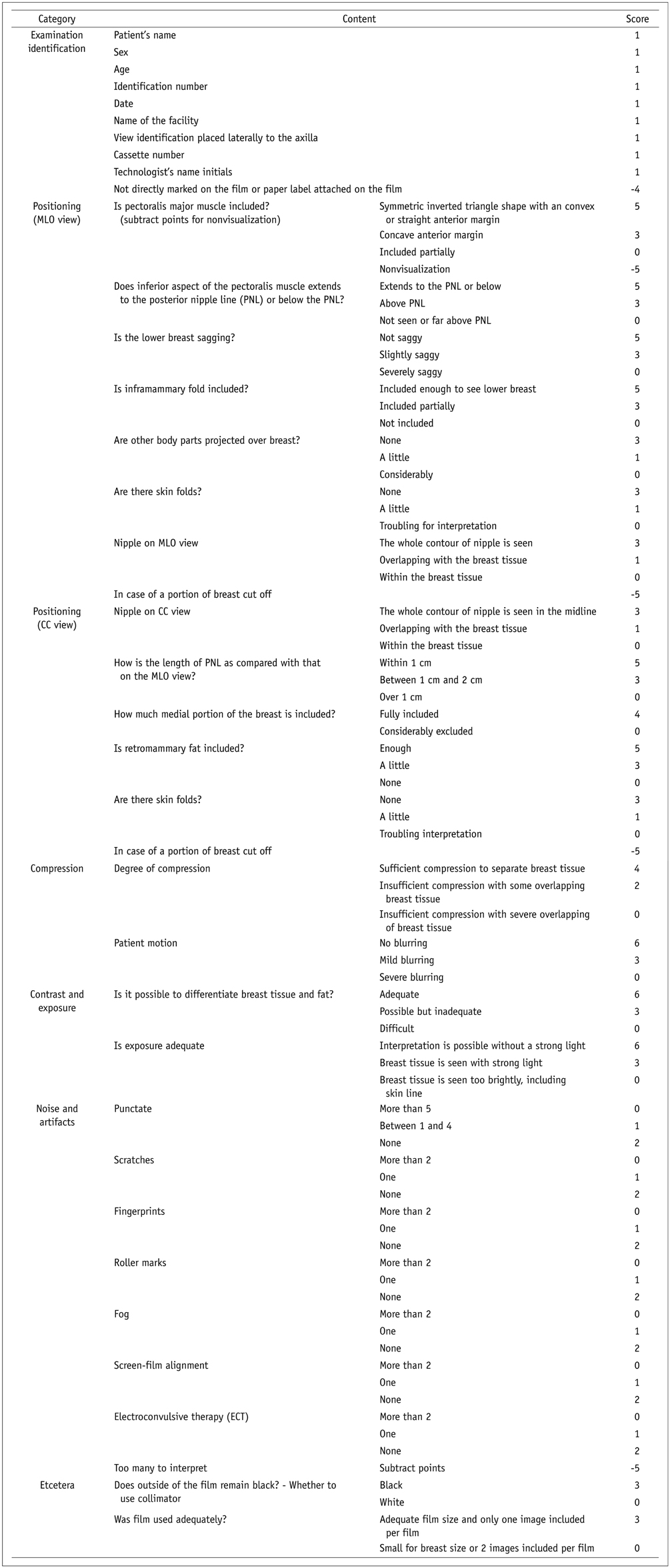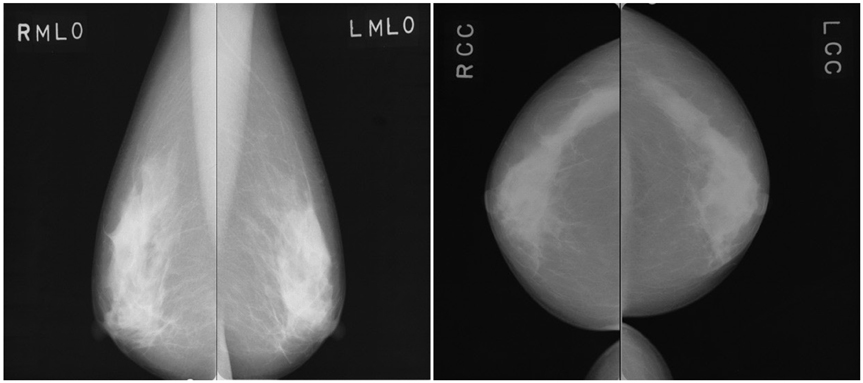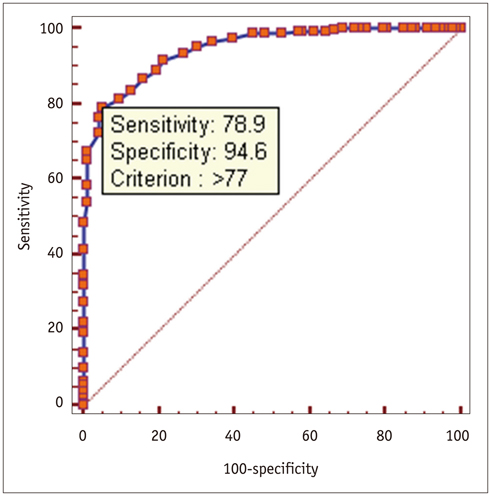Korean J Radiol.
2013 Oct;14(5):701-710. 10.3348/kjr.2013.14.5.701.
Clinical Image Evaluation of Film Mammograms in Korea: Comparison with the ACR Standard
- Affiliations
-
- 1Department of Radiology, Kyungpook National University Medical Center, Daegu 702-210, Korea. mamrad@knu.ac.kr
- 2Department of Radiology and Research Institute of Radiological Science, Yonsei University College of Medicine, Seoul 120-752, Korea.
- 3Department of Radiology, Gangnam Severance Hospital, Yonsei University College of Medicine, Seoul 135-720, Korea.
- 4Department of Radiology, Bundang CHA Hospital, CHA University College of Medicine, Seongnam 463-712, Korea.
- 5Department of Radiology, Dong-A University College of Medicine, Busan 602-715, Korea.
- 6Department of Radiology, Chonnam National University Medical School, Gwangju 501-757, Korea.
- 7Department of Radiology, Kyungpook National University Hospital, Daegu 700-721, Korea.
- KMID: 1711422
- DOI: http://doi.org/10.3348/kjr.2013.14.5.701
Abstract
OBJECTIVE
The goal of this study is to compare the overall quality of film mammograms taken according to the Korean standards with the American College of Radiology (ACR) standard for clinical image evaluation and to identify means of improving mammography quality in Korea.
MATERIALS AND METHODS
Four hundred and sixty eight sets of film mammograms were evaluated with respect to the Korean and ACR standards for clinical image evaluation. The pass and failure rates of mammograms were compared by medical facility types. Average scores in each category of the two standards were evaluated. Receiver operating characteristic curve analysis was used to identify an optimal Korean standard pass mark by taking the ACR standard as the reference standard.
RESULTS
93.6% (438/468) of mammograms passed the Korean standard, whereas only 80.1% (375/468) passed the ACR standard (p < 0.001). Non-radiologic private clinics had the lowest pass rate (88.1%: Korean standard, 71.8%: ACR standard) and the lowest total score (76.0) by the Korean standard. Average scores of positioning were lowest (19.3/29 by the Korean standard and 3.7/5 by the ACR standard). A cutoff score of 77.0 for the Korean standard was found to correspond to a pass level when the ACR standard was applied.
CONCLUSION
We suggest that tighter regulations, such as, raising the Korean pass mark, subtracting more for severe deficiencies, or considering a very low scores in even a single category as failure, are needed to improve the quality of mammography in Korea.
Keyword
MeSH Terms
Figure
Reference
-
1. Korean National Cancer Center. Report on the statistics for national cancer incidence 2006-2007. Korean National Cancer Center;2009.2. Ko SS. Korean Breast Cancer Society. Chronological changing patterns of clinical characteristics of Korean breast cancer patients during 10 years (1996-2006) using nationwide breast cancer registration on-line program: biannual update. J Surg Oncol. 2008; 98:318–323.3. Lee CH. Screening mammography: proven benefit, continued controversy. Radiol Clin North Am. 2002; 40:395–407.4. Kim SH, Kim MH, Oh KK. Analysis and comparison of breast density according to age on mammogram between Korean and Western women. J Korean Radiol Soc. 2000; 42:1009–1014.5. Bassett LW. The regulation of mammography. Semin Ultrasound CT MR. 1996; 17:415–423.6. Suleiman OH, Spelic DC, McCrohan JL, Symonds GR, Houn F. Mammography in the 1990s: the United States and Canada. Radiology. 1999; 210:345–351.7. Destouet JM, Bassett LW, Yaffe MJ, Butler PF, Wilcox PA. The ACR's Mammography Accreditation Program: ten years of experience since MQSA. J Am Coll Radiol. 2005; 2:585–594.8. McLelland R, Hendrick RE, Zinninger MD, Wilcox PA. The American College of Radiology Mammography Accreditation Program. AJR Am J Roentgenol. 1991; 157:473–479.9. Korean Society of Breast Imaging. A manual of the mammography quality control. Seoul: Sung Mun Gak;2001.10. Korean Society of Radiology. Guidance on installation and management of special medical equipments. Accessed April 30, 2012. Available from: http://www.radiology.or.kr.11. Bassett LW, Farria DM, Bansal S, Farquhar MA, Wilcox PA, Feig SA. Reasons for failure of a mammography unit at clinical image review in the American College of Radiology Mammography Accreditation Program. Radiology. 2000; 215:698–702.12. Korean Institute for Accreditation of Medical Image. Accessed April 30, 2012. Available from: http://www.ikiami.or.kr/info/KMI418QD.aspx.13. Korea Ministry of Health and Welfare. National health insurance system. Accessed April 30, 2012. Available from: http://english.mw.go.kr.14. Li Y, Poulos A, McLean D, Rickard M. A review of methods of clinical image quality evaluation in mammography. Eur J Radiol. 2010; 74:e122–e131.15. Lee SH, Choe YH, Chung SY, Kim MH, Kim EK, Oh KK, et al. Establishment of quality assessment standard for mammographic equipments: evaluation of phantom and clinical images. J Korean Radiol Soc. 2005; 53:117–127.16. Moon WK, Kim TJ, Cha JH, Cho KS, Choi EW, Lee YJ, et al. Clinical image evaluation of mammograms: a national survey. J Korean Radiol Soc. 2003; 49:507–511.17. National Institute of Food and Drug Safety Evaluation. Statistics of the diagnostic radiation generator devices installation in the last 5 years. 2010. Accessed April 30, 2012. Available from: http://www.nifds.go.kr.
- Full Text Links
- Actions
-
Cited
- CITED
-
- Close
- Share
- Similar articles
-
- Current Status of Clinical Image Evaluation of Mammograms: Preliminary Report
- New Film-Cassette System to Obtain Wider Field of Craniocaudal View Compared with Conventional Technique in Screening Mammography
- Storage Phosphor Digital Radiography in Portable Chest Imaging: Comparison of Image Quality with Conventional Film-Screen System with Variation of mAs
- A Novel Magnetic Resonance Quality Assurance Phantom (KMRP-4): Multi-Site Comparison With the American College of Radiology Phantom
- Diagnostic accuracy of urine dipstick for proteinuria in older outpatients





